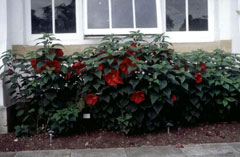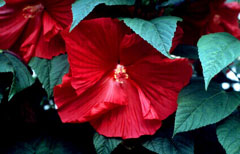 |
|
(c) 2010 Ken Fern & Plants For A Future |
 |
| (c) 2010 Ken Fern & Plants For A Future |
Translate this page:
Summary
Bloom Color: Pink, Red, White.
Main Bloom Time: Early fall, Late summer, Mid fall. Form: Upright or erect.
Physical Characteristics

 Hibiscus moscheutos is a PERENNIAL growing to 2.5 m (8ft) by 2 m (6ft) at a medium rate.
Hibiscus moscheutos is a PERENNIAL growing to 2.5 m (8ft) by 2 m (6ft) at a medium rate.
See above for USDA hardiness. It is hardy to UK zone 5. It is in flower from July to September, and the seeds ripen from August to October. The species is hermaphrodite (has both male and female organs) and is pollinated by Insects.
Suitable for: light (sandy), medium (loamy) and heavy (clay) soils and prefers well-drained soil. Suitable pH: mildly acid, neutral and basic (mildly alkaline) soils. It can grow in semi-shade (light woodland) or no shade. It prefers moist soil.
UK Hardiness Map
US Hardiness Map
Synonyms
Plant Habitats
Cultivated Beds;
Edible Uses
Although there are no reports of edibility for this species, most of the plants in this family have edible leaves and flowers[K]. The flowers are about 15cm in diameter[233], though in some cultivars they are up to 25cm in diameter[260]. They have a mild flavour and somewhat mucilaginous texture with a slight bitterness in the aftertaste[K]. The leaves are rather bland and are also mucilaginous, but have a slight hairiness to them which detracts a little from the pleasure of eating them[K].
References More on Edible Uses
Medicinal Uses
Plants For A Future can not take any responsibility for any adverse effects from the use of plants. Always seek advice from a professional before using a plant medicinally.
Demulcent Dysentery Emollient Urinary
The leaves and roots abound in mucilage[222]. Like many other plants in this family, they are demulcent and emollient and are used in the treatment of dysentery, lung ailments and urinary ailments[222]. an infusion of the dried stalks has been used in the treatment of inflammation of the bladder[257].
References More on Medicinal Uses
The Bookshop: Edible Plant Books
Our Latest books on Perennial Plants For Food Forests and Permaculture Gardens in paperback or digital formats.

Edible Tropical Plants
Food Forest Plants for Hotter Conditions: 250+ Plants For Tropical Food Forests & Permaculture Gardens.
More

Edible Temperate Plants
Plants for Your Food Forest: 500 Plants for Temperate Food Forests & Permaculture Gardens.
More

More Books
PFAF have eight books available in paperback and digital formats. Browse the shop for more information.
Shop Now
Other Uses
References More on Other Uses
Cultivation details
Landscape Uses:Border, Container, Foundation, Specimen. Prefers a well-drained humus rich fertile soil in a sheltered position in full sun[200]. Well-suited to a water-side planting[200]. One report says that the plants are hardy in zone 5 (tolerating winter temperatures down to about -25°c), this same report also says that the plant succeeds outdoors in Britain only in those areas where winter temperatures do not fall below about -5°c[200]. Another report says that it needs to be grown in a warm garden in the warmer areas of Britain[233]. Plants of the cultivar 'Southern Belle' have been seen growing outdoors at Kew Gardens, they are situated on a south-east facing wall of the Temperate House and have been there for at least 3 years as of 2000[K]. A very ornamental plant[1], there are many named varieties[200]. Special Features:North American native, Wetlands plant, Attracts butterflies.
References Carbon Farming Information and Carbon Sequestration Information
Temperature Converter
Type a value in the Celsius field to convert the value to Fahrenheit:
Fahrenheit:
The PFAF Bookshop
Plants For A Future have a number of books available in paperback and digital form. Book titles include Edible Plants, Edible Perennials, Edible Trees,Edible Shrubs, Woodland Gardening, and Temperate Food Forest Plants. Our new book is Food Forest Plants For Hotter Conditions (Tropical and Sub-Tropical).
Shop Now
Plant Propagation
Seed - sow early spring in a greenhouse. Germination is usually rapid. Prick out the seedlings when they are large enough to handle and plant them out into their permanent positions in early summer. Some reports say that the seed can be sown in situ outside and that it gives a good rate of germination[78, 80, 113].
Other Names
If available other names are mentioned here
Native Range
NORTHERN AMERICA: United States (Indiana, Massachusetts, Michigan (south), New Jersey, New York, Ohio, Pennsylvania, West Virginia, Illinois, Alabama, Delaware, Florida (north), Georgia, Kentucky, Louisiana, Maryland, North Carolina, South Carolina, Tennessee, Virginia, Texas) EUROPE: Italy, Spain, Portugal
Weed Potential
Right plant wrong place. We are currently updating this section.
Please note that a plant may be invasive in one area but may not in your area so it's worth checking.
Conservation Status
IUCN Red List of Threatened Plants Status :

| Related Plants
|
| Latin Name | Common Name | Habit | Height | Hardiness | Growth | Soil | Shade | Moisture | Edible | Medicinal | Other |
| Hibiscus acetosella | Cranberry Hibiscus | Annual/Perennial | 1.5 |
9-11
| M | LMH | N | M | 3 | 2 | 3 |
| Hibiscus cannabinus | Kenaf, Brown Indianhemp | Annual/Perennial | 1.8 |
6-12
| F | LMH | N | M | 4 | 2 | 3 |
| Hibiscus diversifolius | Swamp Hibiscus | Shrub | 1.0 |
9-11
| | LMH | N | M | 2 | 1 | |
| Hibiscus heterophyllus | Native Rosella | Shrub | 1.8 |
9-11
| | LMH | N | M | 2 | 0 | 1 |
| Hibiscus mutabilis | Cotton Rose, Dixie rosemallow | Shrub | 3.0 |
7-10
| | LMH | N | M | 2 | 2 | 1 |
| Hibiscus radiatus | Monarch Rosemallow. Ruby hibiscus, Clavelina | Shrub | 2.0 |
9-11
| M | LMH | SN | M | 2 | 1 | 2 |
| Hibiscus rosa-sinensis | Chinese Hibiscus, Shoeblackplant, Hawaiian Hibiscus, Tropical Hibiscus, China Rose, Rose-of-China, S | Shrub | 2.5 |
9-11
| F | LMH | N | M | 3 | 3 | 3 |
| Hibiscus sabdariffa | Roselle | Annual/Perennial | 3.0 |
9-12
| F | LMH | N | M | 3 | 3 | 3 |
| Hibiscus sinosyriacus | Rose Of Sharon | Shrub | 3.0 |
6-9
| M | LMH | SN | M | 4 | 2 | 3 |
| Hibiscus syriacus | Rose Of Sharon, Althaea, Shrub Althea, Hardy Hibiscus | Shrub | 3.0 |
5-9
| M | LMH | SN | M | 4 | 2 | 2 |
| Hibiscus tilliaceus | Beach Hibiscus, Sea Hibiscus | Tree | 8.0 |
10-12
| F | LM | N | DMWe | 2 | 1 | 3 |
| Hibiscus trionum | Flower Of An Hour | Annual/Perennial | 0.6 |
9-11
| F | LMH | N | DM | 2 | 1 | 2 |
| Talipariti tiliaceum | Beach Hibiscus, Sea Hibiscus, Cottontree, Mahoe | Tree | 10.0 |
10-12
| F | LMH | N | MWe | 3 | 2 | 4 |
|
Growth: S = slow M = medium F = fast. Soil: L = light (sandy) M = medium H = heavy (clay). pH: A = acid N = neutral B = basic (alkaline). Shade: F = full shade S = semi-shade N = no shade. Moisture: D = dry M = Moist We = wet Wa = water.
Now available:
Food Forest Plants for Mediterranean Conditions
350+ Perennial Plants For Mediterranean and Drier Food Forests and Permaculture Gardens.
[Paperback and eBook]
This is the third in Plants For A Future's series of plant guides for food forests tailored to
specific climate zones. Following volumes on temperate and tropical ecosystems, this book focuses
on species suited to Mediterranean conditions—regions with hot, dry summers and cool, wet winters,
often facing the added challenge of climate change.
Read More
Expert comment
Author
L.
Botanical References
200274
Links / References
For a list of references used on this page please go here
Readers comment
| Add a comment |
|
If you have important information about this plant that may help other users please add a comment or link below. Only comments or links that are felt to be directly relevant to a plant will be included. If you think a comment/link or information contained on this page is inaccurate or misleading we would welcome your feedback at [email protected]. If you have questions about a plant please use the Forum on this website as we do not have the resources to answer questions ourselves.
* Please note: the comments by website users are not necessarily those held by PFAF and may give misleading or inaccurate information.
To leave a comment please Register or login here All comments need to be approved so will not appear immediately.
|
Subject : Hibiscus moscheutos
|
|
|
|